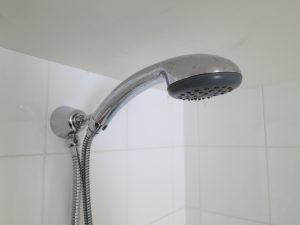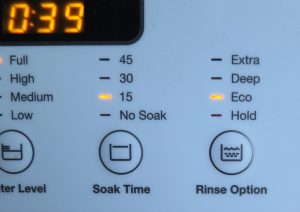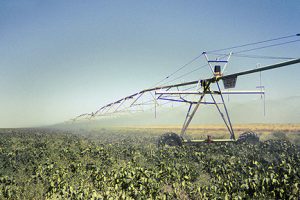| Average Australian home | $1000 a year/700 litres a day* |
|---|---|
| Smart renter | $580 a year/400 litres a day* |
| Very smart renter | $190 a year/130 litres a day* |
*This was calculated based on a combined cost of $3.77 per litre for water and sewage and a national 2010 average of 282 litres of water per person. The above figures also assume that as a renter, you do not pay service charges as is the case in some states (including ours).
We‘ll cover some easy ways that renters can be a water wise household covering mostly indoor use. Next to each section is a percentage of how much water this uses in a typical household.
Bathroom (43%)
- Any shower head that uses 7.5 litres/min or less can be considered to be a water saving shower head. They can be purchased for as little as $30 (or sometimes given away under showerhead exchange programs) and can be easily installed as a renter.
- A water saving shower head will work in any mains or pump pressure property as long as you don’t have an older instant hot water heater (see Slash your water bills article).
- Keep the old shower head to reinstall when you leave unless you have agreed with the landlord to permanently change it.
- Stick to 5 minute showers which means that shaving and brushing your teeth are best done in front of the bathroom sink. You may need a timer at first if you’re not used to 5 minute showers but it becomes easy in no time.
- Baths are a luxury so treat them as such. A foot bath is a nice low water alternative.
- Don’t leave the tap running when shaving or brushing your teeth.

Toilet (14%)
- If you have a dual flush toilet, use the low flush option where appropriate.
- Older toilets can use 12 litres a flush or more. There is a simple fix that renters can use to reduce this to 6 litres a flush.
Laundry (16%)
- Wash clothes only when necessary; if it doesn’t look dirty or smell dirty, it isn’t dirty which means it doesn’t need to be washed. This also saves you time and makes your clothes and washing machine last much longer.
- Clothes can be aired to freshen them up.
- Only wash if you have a full load.
- The above tips should already save you a lot of water so you can keep your current washing machine going until it wears out.
- If you are buying a replacement washing machine, look for one that is water efficient and can wash in cold water (e.g. doesn’t have an internal heater). If the washing machine has a hot and cold water input and a cold wash only setting, than you can wash in cold water.
- Whether it’s a front loader or top loader is irrelevant unless you have specific needs; how much water the machine uses per wash is more important (aim for 70 litres a wash or less).

Kitchen (5%)
- A dishwashing stick can be used to wash dishes as you go, avoiding the need to fill the sink. By air drying dishes, we find it easier than using a dishwasher.
- Dishwashers and handwashing seem to use a similar amount of water so it comes down to personal preference.
- If you have a large designer sink, put a smaller container or wash bucket inside so you don’t need to use so much water to fill the sink.
Outdoor use (22%)
- If you have a car, wash it at a car wash where the water is recycled or bucket wash at home.
- If you want to tidy up paths, driveways or concrete areas, use a broom instead of a hose.
- Pools and spas are massive water users (and a lot of maintenance) so avoid signing up for a property with either of these. Better to use public pools and spas instead.
- See portable wicking beds for a cheap and simple renters garden that uses half the water of a conventional garden.
Extra tips

“Travelling irrigator” by NSW DPI Schools program is licensed under CC BY-NC-SA 2.0 This section is an excerpt of the original.
- Our home water use is just a small part of all the water each of us needs. Reducing food waste, growing your own food and learning to live comfortably on less goods and fossil fuels are also important ways to reduce our water use.
- Make sure water leaks are promptly fixed.
- You should be able to find out your litres per person per day amount from your water bill.
Adopting these water wise ideas as a smart renter shouldn’t cost any more than $50 and a few hours of your time, yet will save you around $400 a year compared to the average Australian home. Aim for a maximum of 150 litres per person per day unless you are growing a lot of your own produce.
Read more in the Slash your water bills article or to cope with future drought scenarios and knock even more off your water bill, see Very water wise smart renter and Greywater for renters.